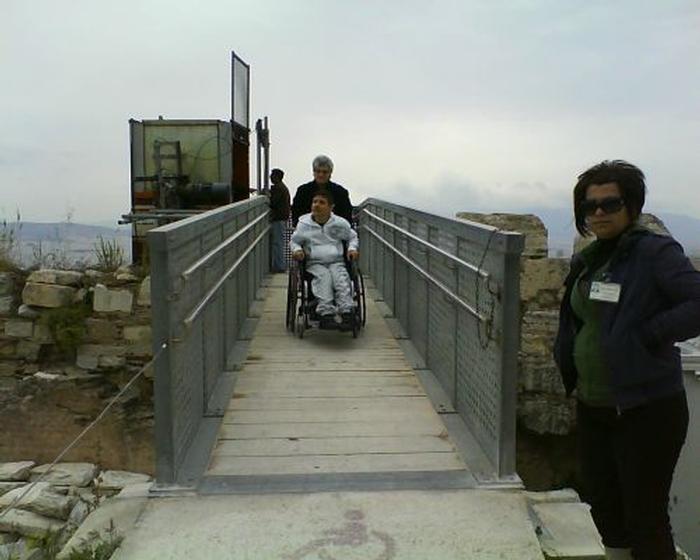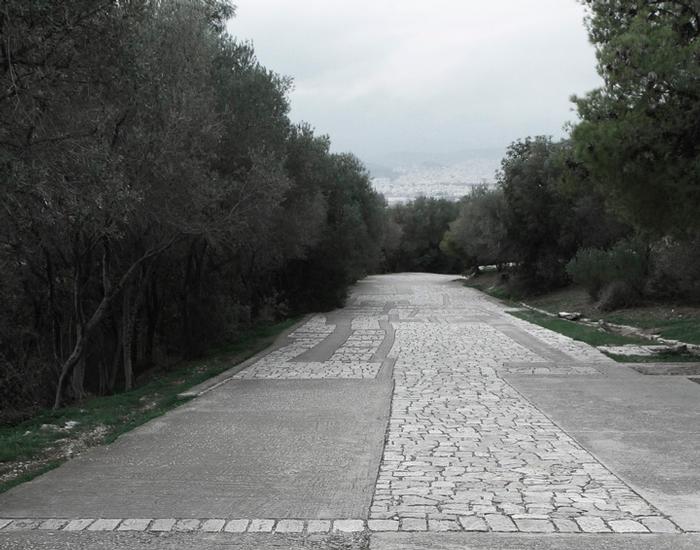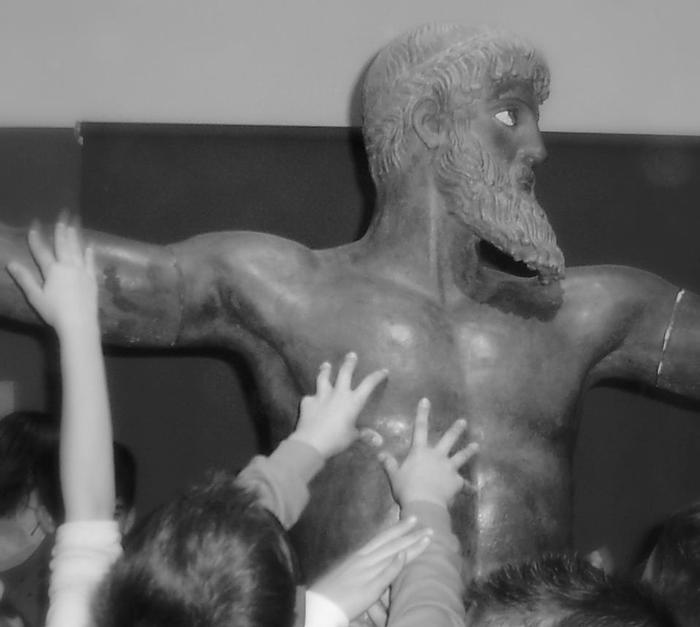[ID:572] Accessibility and Cultural SitesUnited Kingdom I am walking through a narrow street at the heart of Athens. Sun rays play hide and seek trying to avoid the concrete and warm my face, while a breeze carries thoughts and dreams which I make mine with each breath. It is not too difficult to get carried away while watching a mosaic of Doric columns, Corinthian, Ionic and Roman architecture rhythms, Byzantine architectural edifices, neoclassical masterpieces, and modern houses. History, Architecture and Landscape form a unity which put your inner self into a time machine.
This heterogeneous collection of memory fragments from different eras constitutes a synthetic tool as a way of sensing the constant dialectics between myths, legends, the history of the place and the natural landscape.
While I was reaching to the main road towards Acropolis surrounding area, one of the old myths came to my mind. According to that myth, the city of Athens was founded under the struggle between goddess Athena and god of water Poseidon, regarding the name of the city. Athena won with the help of her disabled brother God Hephaestus. In Iliad, Homer describes vividly the scene where Athena visits her brother who ‘grasped a stout staff, and went forth halting; but there moved swiftly to support their lord handmaidens wrought of gold in the semblance of living maids’.
Maybe Hephaestus will to help his sister, urged ancient Athenians to protect the rights of disabled citizens in 4th century B.C. As Aristotle wrote ‘The Council also inspects the Incapables; for there is a law enacting that persons possessing less than 3 minae and incapacitated by bodily infirmity from doing any work are to be inspected by the Council, which is to give them a grant for food at the public expense at the rate of 2 obols a day each’.
Under the veil of myths and legends, which constitute the substrate of culture itself, the notion of equal rights gradually rose to the public dialogue. However, there is a huge gap between the notion of ‘equal rights’, the perception of that notion and reality. This gap is evident throughout the evolution of human society. Demosthenes, a prominent Greek statesman (340 b.c) wrote: ‘When a citizen can walk freely and safely from one part of the city, to another without fear and obstacles at any given time, then he lives in a true Democracy’. That social dimension of equal and safe access of all citizens to every building is evident today.
We could argue that the concept of equal rights, redefinition of disability and review of the framework of what constitutes disability, is directly related with the concept of democracy. It is well known that under totalitarian regimes, the notion of equality somewhat lost its meaning. In Ancient Sparta, children with disabilities were thrown to Kaiadas cliff, in order to sustain a healthy race. Under the reign of the Third Reich, the needs of persons with disabilities were not taken into account during the redesign of urban grid from Albert Speer, Hermann Giesler, and Fritz Todt. As Hitler noted ‘architecture is the word in stone’.
In today’s Democracy, equal accessibility is a fundamental right of every citizen. Architecture itself, as a lady decorated with the democratic ideals, assumes the role to reshape cities and distribute equality in space. An effort to redesign the polis, in other words the cell of human civilization.
However, Democracy should also be seen as a vast puzzle in the ocean of history, where not all the pieces are visible. Each era unveils certain pieces and this is evident to the perception of the human body itself.
The exploration of human nature is an important reference point for architecture which is inevitably linked to the human body. In modern times, during the period of regeneration and establishment of rational thought, Vitruvius relates the proportions of ancient Greek temples to the proportions of the human body.
The scientific study of the human body as an object is stated later on, through a mental schema of mathematical relationships by Leonardo Da Vinci. The Man of Vitruvius which was studied and designed by Leonardo Da Vinci in the table «Canon of Proportions" states the scientific tool that can monitor and determine the "ideal" human body and possibly the ideal man.
The methodical approach of metric components and materials of ideal body proportions was additionally one of the key tools used by architects to connect buildings with the human scale. These tools gradually evolved into standard metrics that describe the human body, determine the human measure and therefore can determine human space. This hypothesis is confirmed by newer approaches such as the analysis of Zeising or Modulor and Le Corbusier.
The vision of the human body from the 60s onwards, begun to change. Today this change is evident in the United Nations Convention on the Rights of Persons with Disabilities. It is evident that the tools of the past that persistently explored the metric relations and material dimensions of the human body, is now inadequate. Undoubtedly, there is a strong relationship between the tools used by the architect to express the human scale in architectural design and the cultural vision of the human body.
Still walking and my eyes struggle to find elements of this cultural shift to the everyday life of disabled persons in Athens. The roads look like veins where the car movement give life to the organism of the city. They transfer ideas and thoughts which mingle with the natural and urban landscape. I stop by the traffic light. Certain signs, ramps and new designed sidewalks regarding persons with disability, prove that the universal notion of kinesis is well established in the urban grid.
It is true that the Olympic Games of 2004 in Athens marked a new beginning in regard to people with physical disabilities. A re-design of all sport stadiums, main roads, sidewalks and archaeological spaces was initiated, in order to become accessible for all people. It becomes evident that the symbolic meaning of the Olympic and Paralympic Games in today's global environment, is directly related to the concept of equal rights. Under this light we understand the power of symbolism which shifts the structure of the urban grid towards a universal design.
While reaching the surrounding area of Acropolis, a poster regarding disabled persons grasp my attention and instantly I forget the constant noise of the machines which want to be heard. Silence covers me while I read the statistics. The percentage of disabled persons in Athens is 5% while in Greece rises to 9.3%. One thousand buses moderated for easy access for every citizen, transfer each day the ideals of equal rights and accessibility. New white coloured taxis especially designed for disabled persons keep at a constant rate the unhindered access to each part of the city.
For a city like Athens which has a layered topography and a chaotic construction activity due to the myriad limitations that the Archaeological Chamber of Greece sets, the re-design of the urban grid for the easy access of all citizens looks like a difficult task. But still, a lot of things changed to the better.
I blinked my eyes and a breath of relief and hope mingles with the Athenian air. I stand for a moment and a long sidewalk which disappears gradually to the horizon, invites me to step in. Each step onwards is a journey in history. The sidewalk was designed under the guidelines of the ancient path and was shaped according to the traces of the ancient entrance to the polis.
It consists of a collection of stone and tile fragments and leads to the Acropolis following an uphill slope. It was created by Greek architect Pikionis in 1958 and was declared by UNESCO as a monument of modern architecture in 1996.
Along the left and right sides of the sidewalk, trees and bushes try to organize the gaze of the walker and create an immaterial synthesis which unites with the materiality of the construction. I gaze up and the view of the Acropolis creates in an instant, a veil which covers my senses. Gradually the concrete disappears, giving its place to the trees while the noise of the machines is taken over by the sound of the cool breeze.
In front of me, appears the hill where Saint Paul gave his speech to the Athenians and changed the course of human history. On my left the New Acropolis Museum, designed by Bernard Tschumi, seeks a dialectic discourse with the surrounding area. The construction of the new Acropolis Museum was followed by the redevelopment of the surrounding area, making it accessible for people with physical disability.
The access to the Museum and its exhibits is unhindered thus creating a feeling of equality for every visitor. All public areas of the New Acropolis Museum have access for wheelchairs, while the Museum provides free of charge wheelchairs which are located at the entrance. Acropolis stands in an altitude of 160m and until the 2004 Olympics it was inaccessible for disabled persons.
However, under the redesign of the natural landscape, a specially designed lift was installed in the North part of the hill in order to facilitate easy access to people with disabilities and transport them to a specially built motorized platform.
This mechanism leads at a slow and stable speed the chair and the person for a short distance towards the boarding point of the elevator. Under the supervision of experienced and specially trained security personnel, visitors using the lift cover a distance of about 25 meters upwards and reach the northwest courtyard of the Erechtheion temple. Onwards, the visitor follows the specially surfaced paths of the archaeological site. At the northeast corner of the Parthenon, the path curves towards the Acropolis Museum and ends on the eastern side of the Parthenon and on the ruins of the Temple of Augustus.
While resting next to the cold marble steps of the New Acropolis Museum, surrounded by visitors, cameras and poster cards, questions like a storm swept away my answers in an instant. Regarding sites of cultural importance is equal and unhindered accessibility enough? Is the re-design of public and private space of Museums enough to transmute the soul of disabled persons and offer them an equal cultural experience? It seemed to me that regarding the experience of a visit to sites of cultural and archaeological importance, equal accessibility is not enough. What is needed is a chance of experiential accessibility.
As part of the expansion of cultural accessibility, museums should face a new challenge: the interaction of visitors with exhibits. The interactive relationship through touch seems not only to ensure equal participation in cultural groups with specific disabilities such as visually impaired people, but also improves communication between exhibits and visitors, thus providing a complete sensory experience. The synthesis of senses and movement are interrelated elements and provide necessary information about the experience of space. Man as "Mind and Body", says Merleau Ponty, is in a dynamic interaction with space, a space "to discover", but also with Time, the meaning of which defines the movement.
For a moment these thoughts gave life to my recent memories and I recalled the feeling I got during my visit to the ‘Museum of Touch’ several weeks before in Athens. A Museum specially designed for people with poor vision. In a special exhibition of ancient Greek statues the people with poor vision led me to pathways long forgotten and I was reminded the fact that space has sounds, has smells and shape. I remember looking again the space like I was seeing it for the first time.
The experience of a museum visit through many and different senses enhances understanding and serves the educational role of the museum, as opposed to the usual visual communication between exhibit – visitors, which restrict it to a level of passive viewing. The emotional charge of contact with a work of art creates a very strong experiential link with history. The rejection of the other senses, from the cultural primacy of vision, is a general feature of modern Western societies generally expressed in spatial perception, and thus defining architectural practise.
The unhindered access of all people to archaeological sites, theatre’s, monuments and places of cultural heritage is of tremendous importance. That access provides a sense and knowledge of the past, while posing questions regarding our human civilization of tomorrow.
Unfortunately, the New Acropolis Museum, the surrounding area and the majority of Greek Museums and cultural sites seem to be prisoners of the dictatorship of vision. The notion of universal design and the re-design of public and private spaces of museums and cultural sites should take into account the importance of sensory experience.
These thoughts coincided with the sound of thunder in the sky. Suddenly, I realized that I should continue walking following the road back to my home. However, a query offered me her companionship on the way back. If I had some kind of disability, would the urban fabric of Athens and the design of the cultural site give me an equal opportunity to observe, to think, to enjoy, to wonder, to learn and to experience in the same way I did today?
If you would like to contact this author, please send a request to info@berkeleyprize.org. |




